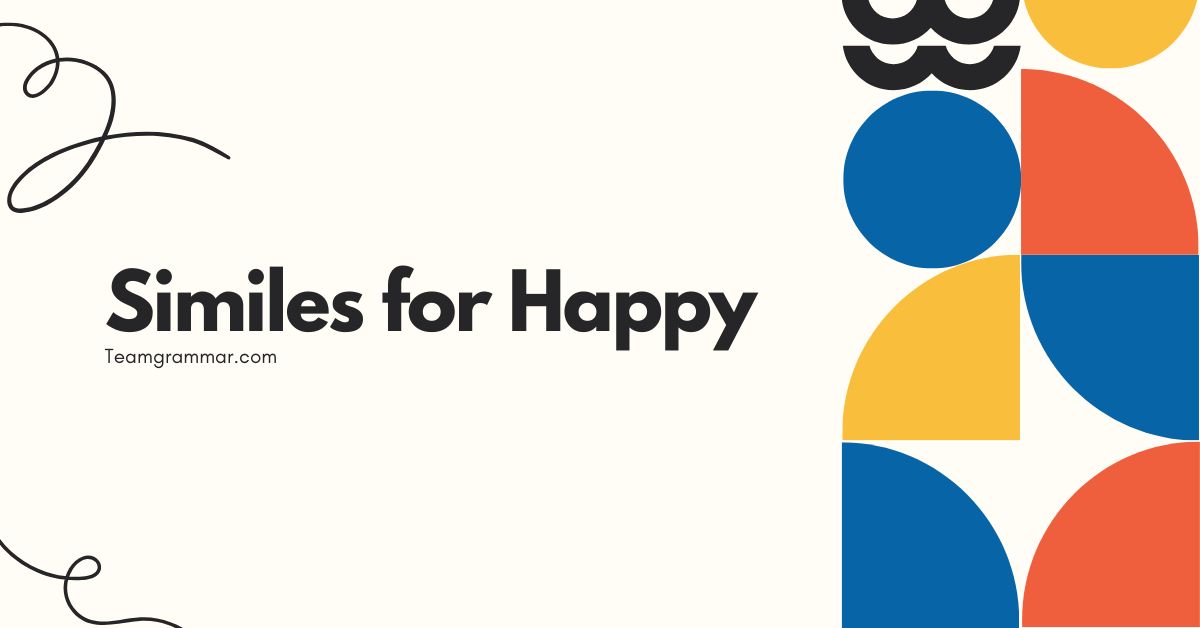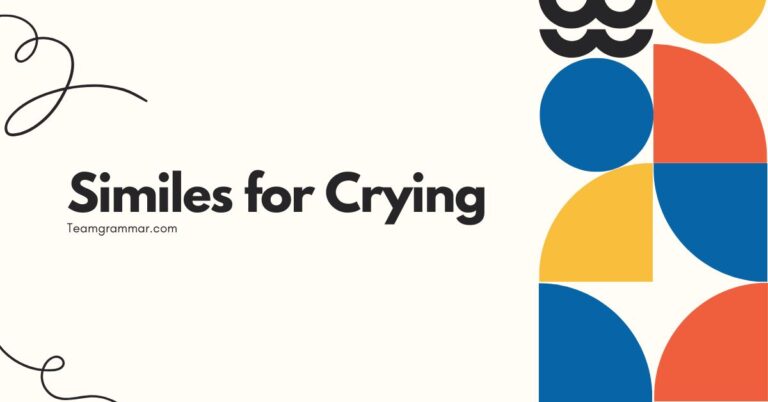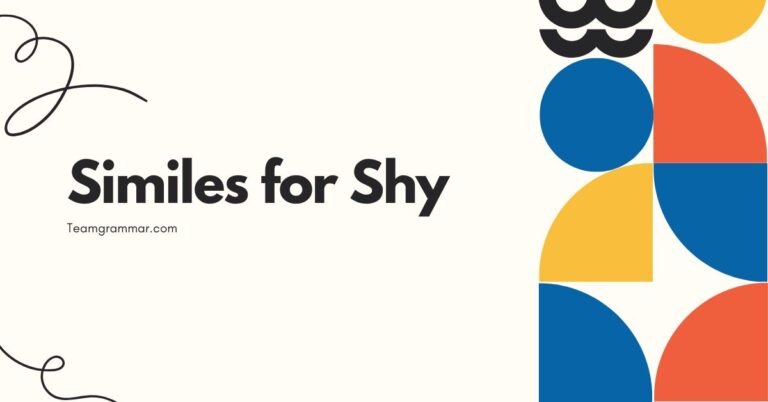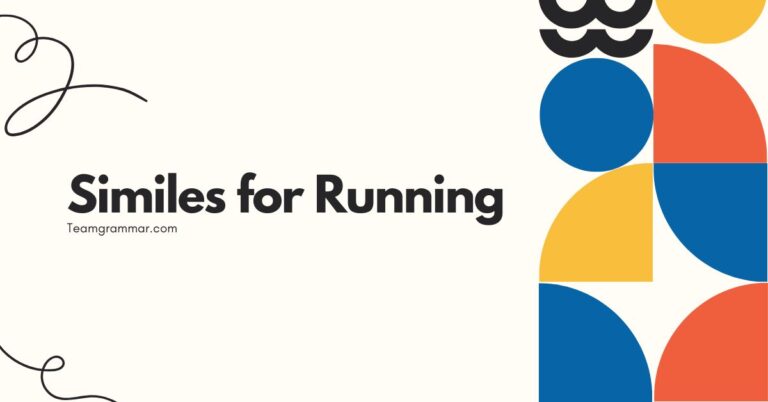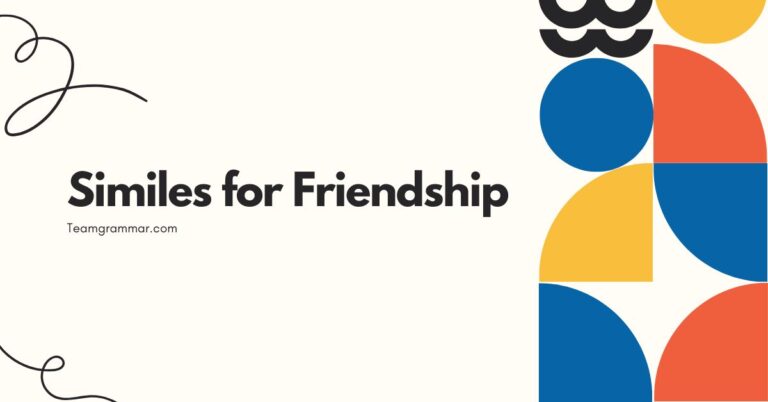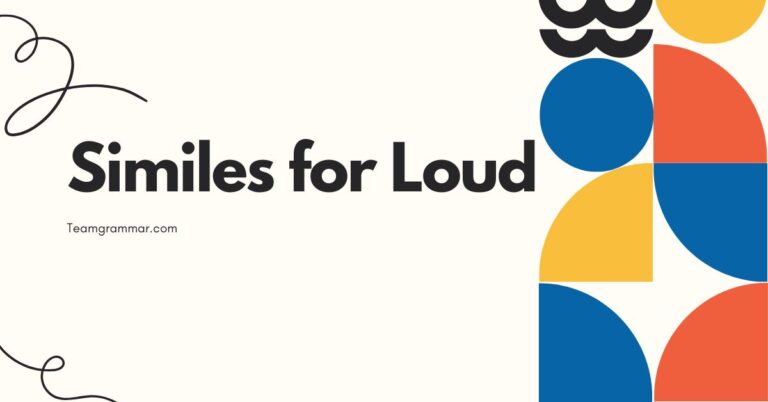39 Similes for Happy: A Comprehensive Guide to Expressing Joy
Understanding and using similes is crucial for enriching your writing and speech. Similes allow you to paint vivid pictures and express emotions with greater impact.
This article focuses on similes used to describe happiness, exploring their structure, variations, and usage. Whether you’re a student, writer, or English language learner, this guide will provide you with the knowledge and tools to effectively use similes to convey happiness in your communication.
Table of Contents
- Introduction
- Definition of Simile
- Structural Breakdown of Similes
- Types of Similes for Happy
- Examples of Similes for Happy
- Usage Rules for Similes
- Common Mistakes with Similes
- Practice Exercises
- Advanced Topics in Similes
- Frequently Asked Questions
- Conclusion
Definition of Simile
A simile is a figure of speech that compares two unlike things using the words “like” or “as.” It is a type of figurative language used to create a vivid image or emphasize a particular quality. Similes help to make descriptions more engaging and relatable by drawing a connection between something familiar and something less so.
They are essential tools for writers and speakers looking to add color and depth to their language.
In essence, a simile works by highlighting a shared characteristic between two disparate entities. This comparison allows the reader or listener to understand the subject more clearly and feel a stronger connection to the described emotion or object.
Understanding the function of a simile is key to effectively incorporating them into your writing and speech.
Classification of Similes
Similes are classified as a type of figurative language, specifically under the umbrella of comparisons. They are distinct from metaphors, which directly state that one thing *is* another, rather than suggesting a similarity.
Similes are also different from analogies, which are more extended and complex comparisons that explain the relationship between two things.
Function of Similes
The primary function of a simile is to enhance description and make it more evocative. By comparing the subject to something familiar, similes can create a stronger impression on the audience.
They are also used to clarify complex ideas, emphasize certain qualities, and add emotional depth to writing and speech.
Contexts for Using Similes
Similes can be used in a wide variety of contexts, including literature, poetry, everyday conversation, and even scientific writing. In literature and poetry, similes are often used to create vivid imagery and enhance the emotional impact of the text.
In everyday conversation, similes can make descriptions more engaging and relatable. Even in scientific writing, similes can be used to explain complex concepts in a more accessible way.
Structural Breakdown of Similes
The basic structure of a simile involves three key components: the subject being described, the comparison word (“like” or “as”), and the object or idea to which the subject is being compared. Understanding this structure is essential for creating effective and grammatically correct similes.
The subject and the object of comparison should be distinctly different but share a common characteristic that is being highlighted. The comparison word acts as the bridge, explicitly stating the similarity between the two.
The comparison word is crucial in differentiating a simile from a metaphor.
The Subject
The subject is the thing being described or compared. It can be a person, place, object, or idea.
The subject is often the focus of the sentence and the reason for using the simile in the first place. Choosing an appropriate subject is the first step in crafting an effective simile.
The Comparison Word
The comparison word is either “like” or “as.” These words signal that a comparison is being made, distinguishing the simile from other figures of speech. While both words can be used interchangeably in many cases, there are subtle differences in their usage.
“Like” is generally used to compare nouns or pronouns, while “as” can be used to compare clauses or phrases.
The Object of Comparison
The object of comparison is the thing to which the subject is being compared. It should be something that is familiar or easily understood by the audience, allowing them to grasp the similarity being drawn.
Selecting an appropriate object of comparison is crucial for the simile to be effective.
Types of Similes for Happy
Similes for “happy” can be categorized based on the specific aspect of happiness they emphasize, such as joy, contentment, excitement, or peace. Understanding these categories can help you choose the most appropriate simile for the specific emotion you want to convey.
Similes Emphasizing Joy
These similes focus on expressions of pure, unadulterated joy. They often involve comparisons to things that are naturally associated with happiness and delight, such as sunshine, laughter, or children playing.
These similes are perfect for describing moments of intense happiness and exhilaration.
Similes Emphasizing Contentment
These similes describe a state of peaceful satisfaction and well-being. They often involve comparisons to things that are comforting and reassuring, such as a warm fire, a cozy blanket, or a quiet evening.
These similes are ideal for describing a sense of inner peace and tranquility.
Similes Emphasizing Excitement
These similes convey a feeling of anticipation and enthusiasm. They often involve comparisons to things that are energetic and stimulating, such as a roller coaster, a fireworks display, or a sports game.
These similes are perfect for describing moments of heightened energy and anticipation.
Similes Emphasizing Peace
These similes describe a state of calm and serenity. They often involve comparisons to things that are tranquil and soothing, such as a still lake, a gentle breeze, or a quiet forest.
These similes are ideal for describing a sense of inner calm and tranquility.
Examples of Similes for Happy
Here are examples of similes that describe happiness, categorized by the specific emotion they convey. Each table contains a variety of similes to illustrate the different ways happiness can be expressed.
Table 1: Similes Emphasizing Joy
The following table presents similes that emphasize the feeling of joy. These examples use comparisons to things that are typically associated with happiness and delight.
| Simile | Explanation |
|---|---|
| As happy as a lark | Describes someone who is very cheerful and carefree. |
| As happy as a clam | Indicates a state of complete contentment and satisfaction. |
| Like a kid in a candy store | Describes someone who is extremely excited and delighted. |
| As happy as the day is long | Implies constant and unwavering happiness. |
| Like sunshine on a cloudy day | Describes happiness that brightens up a situation. |
| As cheerful as a robin in spring | Highlights a bright and optimistic disposition. |
| Like winning the lottery | Expresses immense and unexpected joy. |
| As giddy as a schoolgirl | Conveys lighthearted and silly happiness. |
| Like a dog with two tails | Describes someone who is extremely pleased and excited. |
| As thrilled as a child on Christmas morning | Indicates intense excitement and anticipation. |
| Like a bird in flight | Expresses freedom and joy. |
| As content as a cat purring | Describes a state of peaceful satisfaction. |
| Like a song in your heart | Indicates a deep, internal joy. |
| As bubbly as champagne | Conveys a lively and enthusiastic happiness. |
| Like a warm embrace | Describes a comforting and joyful feeling. |
| As delighted as a painter with a new canvas | Expresses the joy of new beginnings and creative opportunities. |
| Like a dancer hearing their favorite song | Conveys the excitement and passion of pursuing one’s interests. |
| As gleeful as children playing in the snow | Highlights the innocent and pure joy of simple pleasures. |
| Like a hiker reaching the summit of a mountain | Describes the satisfaction and happiness of achieving a goal. |
| As exuberant as a crowd cheering at a concert | Conveys the collective joy and energy of a shared experience. |
| Like a gardener seeing their flowers bloom | Expresses the joy of nurturing and watching something grow. |
| As jovial as a group of friends reminiscing about old times | Highlights the warmth and happiness of shared memories. |
| Like a musician performing on stage | Describes the fulfillment and joy of sharing one’s talents. |
| As merry as carolers singing during the holidays | Conveys the festive and cheerful spirit of a special occasion. |
| Like a student receiving an A+ on an exam | Expresses the joy of academic success and hard work paying off. |
Table 2: Similes Emphasizing Contentment
The table below showcases similes that emphasize contentment. These comparisons are drawn from things that evoke feelings of peace, satisfaction, and tranquility.
| Simile | Explanation |
|---|---|
| As content as a cat purring | Describes a state of peaceful satisfaction. |
| Like a warm blanket on a cold day | Indicates comfort and security. |
| As peaceful as a sleeping baby | Conveys a sense of tranquility and innocence. |
| Like a quiet evening by the fire | Describes a sense of relaxation and contentment. |
| As serene as a still lake | Implies a state of calm and peacefulness. |
| Like a gentle breeze on a summer day | Describes a soothing and pleasant experience. |
| As satisfied as a painter admiring their finished work | Expresses fulfillment in one’s accomplishments. |
| Like finding a forgotten treasure | Indicates unexpected pleasure and contentment. |
| As untroubled as a clear blue sky | Conveys a sense of peace and freedom from worry. |
| Like a well-loved book | Describes being cherished and appreciated. |
| As complete as a perfect circle | Expresses a sense of wholeness and fulfillment. |
| Like a blooming flower in spring | Indicates growth and renewal. |
| As fulfilled as a parent watching their child succeed | Describes the deep satisfaction of seeing loved ones thrive. |
| Like a cozy cabin in the woods | Conveys a sense of warmth, comfort, and isolation. |
| As grateful as a survivor after a disaster | Indicates deep appreciation for life and safety. |
| Like a musician playing a perfectly tuned instrument | Expresses the satisfaction of achieving harmony and precision. |
| As relaxed as someone soaking in a hot bath | Conveys the feeling of being completely at ease and stress-free. |
| Like a writer finally finishing a long-awaited novel | Describes the sense of accomplishment and relief. |
| As content as a chef tasting their own delicious creation | Expresses the satisfaction of creating something wonderful. |
| Like a traveler reaching their destination after a long journey | Conveys the joy and relief of achieving a goal. |
| As peaceful as meditating in a quiet garden | Highlights the tranquility and inner peace of mindfulness. |
| Like a reader getting lost in a captivating book | Describes the joy of immersion and escapism. |
| As satisfied as a teacher seeing their students excel | Expresses the fulfillment of making a positive impact on others. |
| Like a volunteer helping those in need | Conveys the satisfaction of making a difference in the world. |
| As thankful as someone receiving unexpected kindness | Indicates deep appreciation for generosity and compassion. |
Table 3: Similes Emphasizing Excitement
The following table provides similes that highlight excitement. These examples use comparisons to things that are energetic, stimulating, and full of anticipation.
| Simile | Explanation |
|---|---|
| Like a roller coaster ride | Indicates thrilling and exhilarating experience. |
| As excited as a child on Christmas morning | Describes intense anticipation and joy. |
| Like fireworks on the Fourth of July | Conveys explosive and vibrant excitement. |
| As eager as a student awaiting graduation | Implies anticipation and eagerness for the future. |
| Like winning a race | Describes the thrill of victory and accomplishment. |
| As charged as a lightning bolt | Expresses intense energy and enthusiasm. |
| Like attending your favorite band’s concert | Indicates the thrill of experiencing something you love. |
| As animated as a cartoon character | Conveys lively and expressive excitement. |
| Like the anticipation before a first date | Describes nervous and eager excitement. |
| As hyped as a crowd at a sports game | Implies collective excitement and energy. |
| Like the rush of adrenaline | Describes a sudden burst of energy and excitement. |
| As thrilled as an explorer discovering a new land | Conveys the excitement of discovery and adventure. |
| Like the feeling of falling in love | Indicates intense emotional excitement and joy. |
| As eager as a puppy waiting for a treat | Describes simple, pure excitement. |
| Like the moment before a surprise party | Conveys anticipation and suspense. |
| Like a scientist making a groundbreaking discovery | Expresses the thrill and satisfaction of innovation. |
| As electrified as the atmosphere before a thunderstorm | Conveys a sense of impending excitement and energy. |
| Like a dancer taking the stage for a solo performance | Describes the nervous excitement and anticipation of a big moment. |
| As invigorated as someone after a refreshing swim | Conveys a feeling of renewed energy and enthusiasm. |
| Like a child unwrapping a birthday present | Expresses the pure joy and anticipation of receiving a gift. |
| As stimulated as someone exploring a vibrant new city | Highlights the excitement of discovering new experiences and cultures. |
| Like a writer starting a brand-new project | Describes the enthusiasm and creative energy of embarking on something new. |
| As exhilarated as a skydiver jumping out of a plane | Conveys the thrill and adrenaline rush of extreme activities. |
| Like a musician hitting the perfect note during a performance | Expresses the satisfaction and excitement of achieving a moment of perfection. |
| As energized as someone after a strong cup of coffee | Describes the feeling of being awake, alert, and ready to take on the day. |
Usage Rules for Similes
Using similes effectively requires understanding certain rules and guidelines. These rules ensure that the similes are grammatically correct, logically sound, and contribute to the overall quality of the writing or speech.
One of the most important rules is to ensure that the two things being compared are indeed different but share a common characteristic. The comparison should also be clear and easily understood by the audience.
Overusing similes can also diminish their impact, so it’s important to use them sparingly and strategically.
Maintaining Consistency
Ensure that the comparison is consistent and logical. The shared characteristic should be relevant and meaningful.
Avoid comparisons that are too vague or far-fetched.
Ensuring Clarity
The simile should enhance understanding, not confuse the audience. The comparison should be clear and easily grasped.
Avoid using obscure or unfamiliar references.
Striving for Originality
While common similes can be effective, strive to create original comparisons that are fresh and engaging. This can make your writing more memorable and impactful.
Avoiding Clichés
Be cautious of overused similes (clichés) that have lost their impact. While they may be easily understood, they can make your writing seem uninspired.
Instead, try to come up with fresh and original comparisons.
Common Mistakes with Similes
Even experienced writers and speakers can make mistakes when using similes. Being aware of these common errors can help you avoid them and use similes more effectively.
One common mistake is using similes that are illogical or nonsensical. Another is using similes that are too vague or abstract.
Overusing similes or using clichéd similes can also detract from the quality of the writing or speech.
Table 4: Correct vs. Incorrect Similes
The following table highlights common mistakes made when using similes and provides corrected examples.
| Incorrect Simile | Corrected Simile | Explanation |
|---|---|---|
| He was happy like a rock. | He was happy like a lark. | The comparison should be logical and relevant. |
| She felt happy as a wall. | She felt happy as a bird in flight. | The comparison should evoke a sense of happiness. |
| He was as happy as happy. | He was as happy as can be. | Avoid redundant comparisons. |
| She was happy like always. | She was happy like she had won the lottery. | The comparison should be specific and descriptive. |
| He was happy as a thing. | He was happy as a clam. | The object of comparison should be concrete and relatable. |
Practice Exercises
Practice is essential for mastering the use of similes. These exercises will help you identify and create effective similes for describing happiness.
Exercise 1: Identifying Similes
Identify the similes in the following sentences:
| Question | Answer |
|---|---|
| 1. She was as happy as a lark, singing all day long. | as happy as a lark |
| 2. His laughter was like sunshine, brightening up the room. | like sunshine |
| 3. He felt like a kid in a candy store, surrounded by possibilities. | like a kid in a candy store |
| 4. The news made her as cheerful as a robin in spring. | as cheerful as a robin in spring |
| 5. He was as content as a cat purring by the fire. | as content as a cat purring |
| 6. Her smile was like a warm blanket on a cold day. | like a warm blanket on a cold day |
| 7. He felt as peaceful as a sleeping baby. | as peaceful as a sleeping baby |
| 8. She was as serene as a still lake, undisturbed by worries. | as serene as a still lake |
| 9. He was as excited as a child on Christmas morning. | as excited as a child on Christmas morning |
| 10. She felt like fireworks on the Fourth of July, bursting with energy. | like fireworks on the Fourth of July |
Exercise 2: Completing Similes
Complete the following similes with an appropriate comparison:
| Question | Answer |
|---|---|
| 1. She was as happy as _____. | She was as happy as a clam. |
| 2. He felt like _____. | He felt like winning the lottery. |
| 3. She was as cheerful as _____. | She was as cheerful as a robin in spring. |
| 4. He was as content as _____. | He was as content as a cat purring. |
| 5. She felt like _____. | She felt like a warm embrace. |
| 6. He was as peaceful as _____. | He was as peaceful as a sleeping baby. |
| 7. She felt like _____. | She felt like a gentle breeze on a summer day. |
| 8. He was as excited as _____. | He was as excited as a child on Christmas morning. |
| 9. She felt like _____. | She felt like a roller coaster ride. |
| 10. He was as eager as _____. | He was as eager as a student awaiting graduation. |
Exercise 3: Creating Similes
Create your own similes to describe the following scenarios:
| Scenario | Possible Simile |
|---|---|
| 1. A child receiving a new toy. | The child was as happy as if they had found a pot of gold. |
| 2. Someone winning a competition. | He felt like he had conquered the world. |
| 3. A person relaxing on a beach. | She was as content as a sea otter floating on its back. |
| 4. Someone achieving a long-term goal. | He felt like he had climbed the highest mountain and planted his flag. |
| 5. A couple getting married. | They were as happy as two birds building a nest together. |
| 6. A student passing an important exam. | She felt like she had unlocked the secrets of the universe. |
| 7. A musician performing on a big stage. | He was as excited as a rocket launching into space. |
| 8. A traveler reaching a beautiful destination. | She felt like she had stepped into a postcard. |
| 9. A gardener seeing their flowers bloom. | He was as proud as a parent watching their child graduate. |
| 10. A painter finishing a masterpiece. | She felt like she had captured the essence of beauty itself. |
Advanced Topics in Similes
For advanced learners, exploring the nuances of similes can lead to a deeper understanding of their power and potential. This includes examining the use of extended similes, the interplay between similes and metaphors, and the cultural variations in simile usage.
Extended similes involve developing a comparison over several sentences or even paragraphs, allowing for a more detailed and nuanced exploration of the similarities between two things. Understanding how similes and metaphors can be used together can also enhance the richness and complexity of your writing.
Finally, being aware of cultural differences in simile usage can help you avoid misunderstandings and communicate more effectively with people from different backgrounds.
Extended Similes
An extended simile is a simile that is developed over several lines or even a whole paragraph. It allows for a more detailed and nuanced comparison.
Similes and Metaphors
Understanding the difference between similes and metaphors is crucial for effective writing. While similes use “like” or “as” to make a comparison, metaphors directly equate two things.
Cultural Variations in Similes
Similes can vary significantly across cultures. What is a common and understandable comparison in one culture may be confusing or even offensive in another.
Frequently Asked Questions
Here are some frequently asked questions about similes:
-
What is the difference between a simile and a metaphor?
A simile uses “like” or “as” to compare two things, while a metaphor directly states that one thing *is* another. For example, “He is like a lion” (simile) versus “He is a lion” (metaphor).
-
Can a simile be a cliché?
Yes, a simile can become a cliché if it is overused and has lost its impact. It’s best to avoid clichés and strive for originality.
-
How can I make my similes more effective?
To make your similes more effective, ensure the comparison is logical, clear, and original. Avoid clichés and use specific, descriptive language.
-
Is it okay to use similes in formal writing?
Yes, similes can be used in formal writing, but they should be used sparingly and strategically to enhance the text without making it seem too informal.
-
What are some examples of similes that describe happiness?
Examples include: “as happy as a lark,” “like a kid in a candy store,” and “as content as a cat purring.”
-
Why are similes important in writing?
Similes are important because they can make writing more vivid, engaging, and relatable. They help to create stronger images and emphasize particular qualities.
-
How do I avoid making mistakes when using similes?
To avoid mistakes, ensure that the comparison is logical, clear, and not redundant. Avoid using clichés and be mindful of cultural differences.
-
Can I use similes in everyday conversation?
Yes, similes can be used in everyday conversation to make your descriptions more engaging and relatable.
-
What is an extended simile?
An extended simile is a simile that is developed over several lines or even a whole paragraph, allowing for a more detailed and nuanced comparison.
-
How do cultural differences affect the use of similes?
Similes can vary significantly across cultures. What is a common comparison in one culture may be confusing or offensive in another. It’s important to be mindful of these differences to avoid misunderstandings.
Conclusion
Mastering the use of similes is a valuable skill for anyone looking to enhance their writing and communication. By understanding the structure, types, and usage rules of similes, you can effectively convey emotions, create vivid imagery, and engage your audience.
This article has provided a comprehensive guide to using similes for “happy,” offering numerous examples, exercises, and tips for improvement.
Remember to practice regularly and strive for originality in your comparisons. Pay attention to the context and audience to ensure that your similes are appropriate and effective.
With consistent effort, you can become proficient in using similes to express happiness and other emotions with clarity and impact. Keep exploring, experimenting, and refining your skills to unlock the full potential of this powerful figure of speech.

